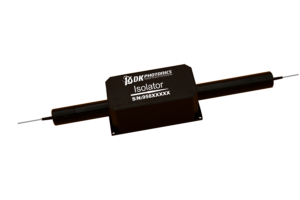What is a PM Isolator?
A PM Isolator is a passive device that allows the transmission of the optical signals in only one direction and blocks all the unwanted optical reflections with the help of polarization-maintaining fiber. Hence, they are named polarization-maintaining isolators. The general category of PM isolators is optical isolators. In this blog, we will explore the different types and applications of optical isolators.

Types of Optical Isolators
Optical Isolators come in different versions, namely:
- Polarization-sensitive isolators
- Polarization insensitive isolators
Both types of optical isolators can block any returning/reflecting light irrespective of the input polarization. The only difference is that, in polarization-sensitive isolators, the insertion losses are dependent on the input polarization. On the other hand, in polarization-insensitive isolators, insertion losses remain constant.
Polarization-sensitive isolators have a simple design and are well suitable for polarization-maintaining (PM) fiber applications and other applications where an input free space beam with fixed polarization enters the Faraday optical system. In both cases, polarization-maintaining fiber is positioned in alignment with the transmission axis of the isolator.
However, polarization-sensitive isolators are not suitable for applications that use standard single-mode fibers because they don’t maintain polarization. Hence, when you need isolators in applications that require maintaining polarization, we recommend using polarization-maintaining isolators (PM Isolators).
Various Applications of PM Isolators
PM isolators are often used in optical systems that require the unperturbed, unidirectional transmission of optical signals. For instance, a single-frequency semiconductor laser is highly sensitive to external optical feedback. Even a very low level of reflection can from an external optical circuit can significant laser phase noise, intensity noise, and wavelength instability. Thus, optical isolators are typically used to keep the optical noise low and optical frequency stable.
An example of a traditional optical isolator is the Faraday isolator. It is made by a Faraday rotator which is sandwiched between two polarizers. Most optical isolators use the Faraday Effect to accomplish their function. This effect commands the rotation of the polarization plane of an optical beam in the presence of the magnetic field. This rotation occurs in the same direction of light traveling parallel or anti-parallel to the direction of the magnetic field.
Since optical isolators allow the propagation of light signals in only one direction, they are also useful as valves. Apart from optical systems, these isolators are used in high-power applications in which one-way transmission of light is required. The same goes for laser amplifiers because even if a small amount of light is reflected back into an amplifier, it would amplify as it will pass through different stages and thus, the optical damage would become more pronounced. Thus, the use of isolators becomes vital to prevent back reflections in optical communications.

Leave A Comment